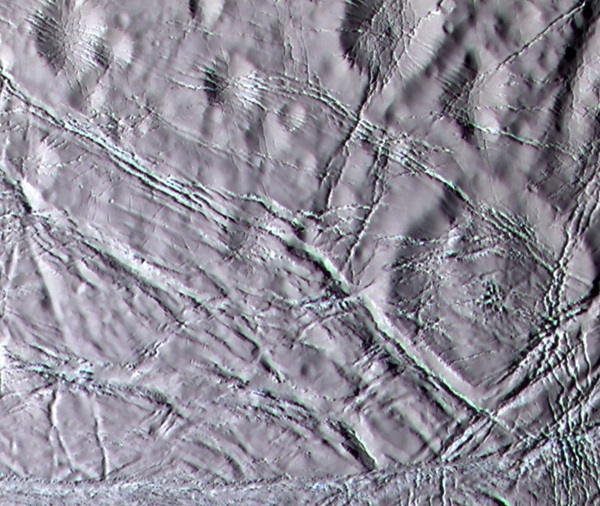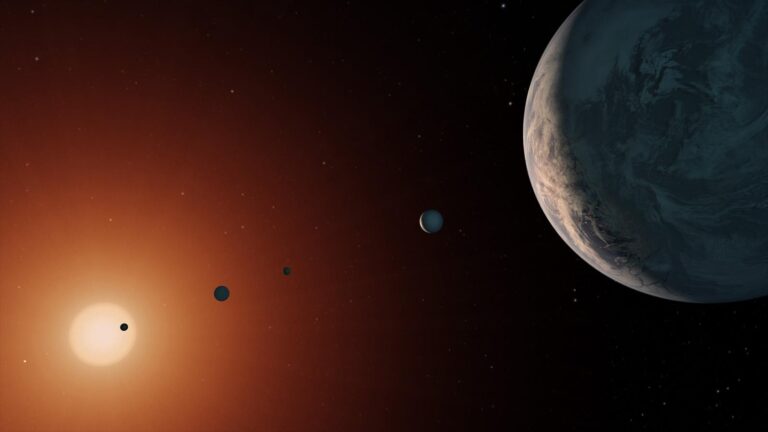Mapping of global color patterns and measurements of surface layer thicknesses show that ice particles fall back onto the surface of Enceladus in a predictable pattern. Mapping of these deposits indicates that the plumes and their heat source are relatively long-lived features lasting millennia and probably tens of million years or more, and have blanketed areas of the surface in a thick layer of tiny ice particles.
“The discovery by instruments aboard the Cassini orbiter that there’s a currently active plume of icy dust and vapor from Enceladus has revolutionized planetary science,” said Schenk. “Earlier this year, we published work that showed material from Enceladus’ plumes coats the surfaces of Saturn’s icy moons. Now, we’ve uncovered two lines of evidence that point to thick deposits of plume material coating the surface of Enceladus itself.”
Models of plume particle trajectories under the influence of Saturn’s gravity show that some particles return to Enceladus in a distinctive pattern. This work by Sasha Kempf from the Max Planck Institute and Juergen Schmidt and colleagues from the University of Potsdam, Denmark, predicts that the heaviest accumulation will be along two longitudes on opposite sides of the satellite. Global color mapping of Enceladus by Schenk and colleagues also shows a globally symmetric pattern of bluish material along two longitudes on opposite sides of the satellite. Comparison of these two maps shows a very close correspondence in the predicted and observed patterns, confirming the prediction of particle deposition on the surface of Enceladus.
Confirmation of plume fallout led Schenk and colleagues to search for physical evidence of plume particle accumulation on the surface. They examined the highest-resolution images north of the plume formation sites; the best of these has a resolution of 39 feet (12 meters). The image reveals unusually smooth terrains with ghost-like topographic undulations, indicating burial of older fractures and craters. Mapping the topography of the site at high resolution, they also found changes in slope along the rims of many of the deeper fractures, or canyons. The larger of these canyons are 1,650 feet (500 m) deep and 0.9 mile (1.5 kilometers) across, not unlike the Black Canyon of the Gunnison in Colorado. These breaks in slope occur approximately 245 to 410 feet (75 to 125 m) below the rims of the canyon walls and correspond to elevations where more rugged crustal material is exposed part way down the canyon walls.
The ghost-like features on the plains and the slope breaks on steep canyon walls are interpreted as due to the formation of a loose, poorly consolidated material lying on top of more solid crustal ices — the craggy rugged exposures part way down the canyon walls. This layer is believed to be the accumulated plume deposits observed in the global color mapping, forming a mantling blanket across the terrain. The layer is on average roughly 350 feet (100m) deep in this area. At least three additional sites show similar evidence of burial, but the resolution of these images is not as good and measurements of thicknesses there are not yet possible.
So, given what we now know, what might conditions be like on Enceladus itself? The models of plume deposition indicate that the rate of deposition on Enceladus is extremely slow by Earth standards, less than a thousandth of a millimeter per year. To accumulate 330 feet (100m) of deposits would require a few tens of millions of years or so. This is important as it suggests that the thermal heat source required driving the plumes and maintaining any liquid water under the icy crust would also have to be similarly long-lived. Without replenishment, the E-ring formed by ejected plume particle would dissipate in hundreds to thousands of years.
What about the surface itself? Could we go skiing on Enceladus?
“Bulky space suits and extremely low gravity aside — the surface gravity there is only roughly 1 percent that of Earth’s — the particles themselves are only a fraction of a millimeter in size, roughly a micron or two across, even finer than talcum powder. This would make for the finest powder a skier could hope for,” said Schenk, who admited he has never been on the slopes himself.
While much smaller than the typical snowflake, the persistence of this “flurry” of tiny icy particles gently snowing down from the plumes to the far south is directly responsible for the slow but steady accumulation of fine ice particulates, or “snow,” across large areas of Enceladus today. Although long suspected, the global color patterns and high-resolution observations are the first direct confirmation and indication of how and where this fallout onto the surface of Enceladus occurs. This accumulation will have important implications for our future understanding of the internal heating mechanism driving the plumes, and for the insulating properties of the surface we see today. Additional work necessary to understanding this phenomenon will require new high-resolution images during encounters with Enceladus planned for 2012 and 2015 during Cassini’s extended mission.
Mapping of global color patterns and measurements of surface layer thicknesses show that ice particles fall back onto the surface of Enceladus in a predictable pattern. Mapping of these deposits indicates that the plumes and their heat source are relatively long-lived features lasting millennia and probably tens of million years or more, and have blanketed areas of the surface in a thick layer of tiny ice particles.
“The discovery by instruments aboard the Cassini orbiter that there’s a currently active plume of icy dust and vapor from Enceladus has revolutionized planetary science,” said Schenk. “Earlier this year, we published work that showed material from Enceladus’ plumes coats the surfaces of Saturn’s icy moons. Now, we’ve uncovered two lines of evidence that point to thick deposits of plume material coating the surface of Enceladus itself.”
Models of plume particle trajectories under the influence of Saturn’s gravity show that some particles return to Enceladus in a distinctive pattern. This work by Sasha Kempf from the Max Planck Institute and Juergen Schmidt and colleagues from the University of Potsdam, Denmark, predicts that the heaviest accumulation will be along two longitudes on opposite sides of the satellite. Global color mapping of Enceladus by Schenk and colleagues also shows a globally symmetric pattern of bluish material along two longitudes on opposite sides of the satellite. Comparison of these two maps shows a very close correspondence in the predicted and observed patterns, confirming the prediction of particle deposition on the surface of Enceladus.
Confirmation of plume fallout led Schenk and colleagues to search for physical evidence of plume particle accumulation on the surface. They examined the highest-resolution images north of the plume formation sites; the best of these has a resolution of 39 feet (12 meters). The image reveals unusually smooth terrains with ghost-like topographic undulations, indicating burial of older fractures and craters. Mapping the topography of the site at high resolution, they also found changes in slope along the rims of many of the deeper fractures, or canyons. The larger of these canyons are 1,650 feet (500 m) deep and 0.9 mile (1.5 kilometers) across, not unlike the Black Canyon of the Gunnison in Colorado. These breaks in slope occur approximately 245 to 410 feet (75 to 125 m) below the rims of the canyon walls and correspond to elevations where more rugged crustal material is exposed part way down the canyon walls.
The ghost-like features on the plains and the slope breaks on steep canyon walls are interpreted as due to the formation of a loose, poorly consolidated material lying on top of more solid crustal ices — the craggy rugged exposures part way down the canyon walls. This layer is believed to be the accumulated plume deposits observed in the global color mapping, forming a mantling blanket across the terrain. The layer is on average roughly 350 feet (100m) deep in this area. At least three additional sites show similar evidence of burial, but the resolution of these images is not as good and measurements of thicknesses there are not yet possible.
So, given what we now know, what might conditions be like on Enceladus itself? The models of plume deposition indicate that the rate of deposition on Enceladus is extremely slow by Earth standards, less than a thousandth of a millimeter per year. To accumulate 330 feet (100m) of deposits would require a few tens of millions of years or so. This is important as it suggests that the thermal heat source required driving the plumes and maintaining any liquid water under the icy crust would also have to be similarly long-lived. Without replenishment, the E-ring formed by ejected plume particle would dissipate in hundreds to thousands of years.
What about the surface itself? Could we go skiing on Enceladus?
“Bulky space suits and extremely low gravity aside — the surface gravity there is only roughly 1 percent that of Earth’s — the particles themselves are only a fraction of a millimeter in size, roughly a micron or two across, even finer than talcum powder. This would make for the finest powder a skier could hope for,” said Schenk, who admited he has never been on the slopes himself.
While much smaller than the typical snowflake, the persistence of this “flurry” of tiny icy particles gently snowing down from the plumes to the far south is directly responsible for the slow but steady accumulation of fine ice particulates, or “snow,” across large areas of Enceladus today. Although long suspected, the global color patterns and high-resolution observations are the first direct confirmation and indication of how and where this fallout onto the surface of Enceladus occurs. This accumulation will have important implications for our future understanding of the internal heating mechanism driving the plumes, and for the insulating properties of the surface we see today. Additional work necessary to understanding this phenomenon will require new high-resolution images during encounters with Enceladus planned for 2012 and 2015 during Cassini’s extended mission.










